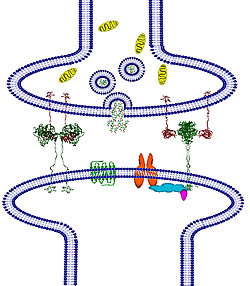A newly discovered transmembrane protein called "Wurst" (sausage) appears to play a decisive role in breathing – possibly in all animals, from flies to human beings. This insight is reported by scientists from the University of Bonn and the Göttingen-based Max Planck Institute for Biophysical Chemistry.
Brain
A protein found primarily in the lens of the eye could be the critical "tipping point" in the spiral of inflammation and damage that occurs in multiple sclerosis, researchers at the Stanford University School of Medicine report.
This protein - alphaB-crystallin - is not normally found in the brain, but develops in response to the injuries inflicted on nerve cells by multiple sclerosis. The nerve-cell injuries can cause people to suffer loss of motor control and even paralysis.
A new therapy to re-activate silenced genes in patients who suffer from neurodegenerative diseases or stroke is being developed by researchers at the University of Illinois at Chicago and Cornell University.
During and after a stroke, certain cellular events take place that lead to the death of brain cells. Compounds that inhibit a group of enzymes called histone deacetylases can modulate gene expression, and in some cases produce cellular proteins that are actually neuroprotective -- they are able to block cell death.
As a result of mapping the structure of the protein complex implicated in autism spectrum disorders, a research team led by scientists at University of California, San Diego have discovered how particular genetic mutations affect this complex and contribute to the developmental abnormalities found in children with autism. Their work should help scientists pinpoint the consequences of other genetic abnormalities associated with the disorder. Neuroligin/neurexin complex in the synapse
Neuroligin/neurexin complex in the synapse
Although most Americans believe they know what brought down the World Trade Center twin towers on Sept. 11, 2001, civil engineers are still seeking answers to questions that could save lives in the future.
Structural engineers need to know from a scientific perspective what happened to the buildings during the terrorist attacks in order to prevent future failures. The search for answers continues with the help of a state-of-the-art animated visualization created by researchers at Purdue University.Source: Purdue University
A decade or so ago, a spate of high profile legal cases arose in which people were accused, and often convicted, on the basis of “recovered memories.” These memories, usually recollections of childhood abuse, arose years after the incident occurred and often during intensive psychotherapy.
So how accurate are recovered memories? The answer is not so clear. In fact, this question has lead to one of the most contentious issues in the fields of psychology and psychiatry.
It's no secret that humans can recognize siblings on a biological level. Now it turns out plants can also, according to biologists at McMaster University. Even more, they get downright competitive with strangers of the same species.
Primates with severe Parkinson’s disease were able to walk, move, and eat better, and had diminished tremors after being injected with human neural stem cells, a research team from Yale, Harvard, the University of Colorado, and the Burnham Institute report today.
The unique cooperation model used in the political field by the countries around the Baltic Sea needs to be extended to the public-private sector in order to increase the competitiveness and attractiveness of the Baltic Sea Region. This was one of the main conclusions reached by the leading representatives from business, government and research within the ICT and Life-Science at the seminar "Talents on Top of Europe" at the Nordic Embassies in Berlin today.
Women who enjoy good childhood relationships with their fathers are more likely to select partners who resemble their dads research suggests.
In contrast, the team of psychologists from Durham University and two Polish institutions revealed that women who have negative or less positive relationships were not attracted to men who looked like their male parents.
Experts present an analysis of long term data on the success of stem cell transplantation for osteopetrosis patients which suggests second transplants should be considered a key option.
Osteopetrosis is a rare disease and devastating for those it afflicts. Children born with this genetic disorder may suffer blindness as early as a few months after birth. Hearing loss is also associated with osteopetrosis, as is a tendency to suffer bone fractures.
Scientists at the University of Portsmouth are using the latest breakthroughs in artificial intelligence to develop the world's first thinking car wheel.
The 'smart' wheel is being developed under a £200K Department of Trade and Industry-funded Knowledge Transfer Partnership (KTP) project with Hampshire-based company PML Flightlink Ltd. A University of Portsmouth Scientist works on the wheel. Credit: Russell Sach
A University of Portsmouth Scientist works on the wheel. Credit: Russell Sach
An international study by researchers at Seattle Children’s Hospital Research Institute, the University of Washington School of Medicine, and Radboud University in Nijmegen, Netherlands has identified a new genetic cause for Joubert syndrome (JS).
The vocal learning process in the zebra finch offers a model system to study the neural and behavioral mechanisms by which humans learn to produce sounds. Songbirds such as zebra finches have specialized areas of their brains devoted to communication. That is why they have been used as animal models to study speech disorders, such as stuttering. It is estimated that more than 3 million Americans stutter.
An international research team has discovered a gene that, when mutated, causes one of the most common forms of inherited blindness in babies. Scientists at the University of Leeds, working in collaboration with experts from other centres around the world, identified the gene, which is essential to photoreceptors in the eye, the cells that "see" light.